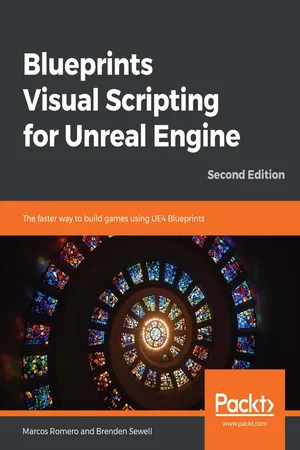
Blueprints Visual Scripting for Unreal Engine
The faster way to build games using UE4 Blueprints, 2nd Edition
- 380 pages
- English
- ePUB (mobile friendly)
- Available on iOS & Android
Blueprints Visual Scripting for Unreal Engine
The faster way to build games using UE4 Blueprints, 2nd Edition
About this book
Publisher's note: This edition from 2019 is based on Unreal Engine 4 and does not make use of the most recent Unreal Engine features. A new third edition, updated for Unreal Engine 5 blueprints including new topics, such as implementing procedural generation and creating a product configurator, has now been published.
Key Features
- Design a fully functional game in UE4 without writing a single line of code
- Implement visual scripting to develop gameplay mechanics, UI, visual effects, VR and artificial intelligence
- Deploy your game on multiple platforms and share it with the world
Book Description
Blueprints is the visual scripting system in Unreal Engine that enables programmers to create baseline systems and can be extended by designers.
This book helps you explore all the features of the Blueprint Editor and guides you through using Variables, Macros, and Functions. You'll also learn about object-oriented programming (OOP) and discover the Gameplay Framework. In addition to this, you'll learn how Blueprint Communication allows one Blueprint to access information from another Blueprint. Later chapters will focus on building a fully functional game using a step-by-step approach. You'll start with a basic first-person shooter (FPS) template, and each chapter will build on the prototype to create an increasingly complex and robust game experience. You'll then progress from creating basic shooting mechanics to more complex systems, such as user interface elements and intelligent enemy behavior. The skills you will develop using Blueprints can also be employed in other gaming genres. In the concluding chapters, the book demonstrates how to use arrays, maps, enums, and vector operations. Finally, you'll learn how to build a basic VR game.
By the end of this book, you'll have learned how to build a fully functional game and will have the skills required to develop an entertaining experience for your audience.
What you will learn
- Understand programming concepts in Blueprints
- Create prototypes and iterate new game mechanics rapidly
- Build user interface elements and interactive menus
- Use advanced Blueprint nodes to manage the complexity of a game
- Explore all the features of the Blueprint editor, such as the Components tab, Viewport, and Event Graph
- Get to grips with object-oriented programming (OOP) concepts and explore the Gameplay Framework
- Learn Virtual Reality development with UE Blueprint
Who this book is for
This book is for anyone who is interested in developing games or applications with UE4. Although basic knowledge of Windows OS is required, experience in programming or UE4 is not necessary.
Frequently asked questions
- Essential is ideal for learners and professionals who enjoy exploring a wide range of subjects. Access the Essential Library with 800,000+ trusted titles and best-sellers across business, personal growth, and the humanities. Includes unlimited reading time and Standard Read Aloud voice.
- Complete: Perfect for advanced learners and researchers needing full, unrestricted access. Unlock 1.4M+ books across hundreds of subjects, including academic and specialized titles. The Complete Plan also includes advanced features like Premium Read Aloud and Research Assistant.
Please note we cannot support devices running on iOS 13 and Android 7 or earlier. Learn more about using the app.
Information
Section 1: Blueprint Fundamentals
- Chapter 1, Exploring the Blueprint Editor
- Chapter 2, Programming with Blueprints
- Chapter 3, Actors and the Gameplay Framework
- Chapter 4, Understanding Blueprint Communication
Exploring the Blueprint Editor
- Installing Unreal Engine
- New projects and templates
- Blueprints Visual Scripting
- The Blueprint Editor interface
- Adding Components to a Blueprint
Installing Unreal Engine
- Access the website (https://www.unrealengine.com)
- Register and download Epic Games Launcher
- Install and start the launcher
- Click the Unreal Engine tab on the left-hand side
- Click on the Library tab that appears at the top of the screen
- Click the + button next to ENGINE VERSIONS to add a version of Unreal Engine to the launcher
- Click the Install button
- Click the Launch button to start an already installed version:

Creating new projects and using templates

- Target hardware: Desktop / Console or mobile/tablet
- Graphical level: Maximum Quality or scalable 3D/2D
- Starter content: With or without Starter Content
- First Person: For games with a first-person perspective
- Flying: Contains a simple spaceship controlled by the player
- Handheld AR: For augmented reality applications
- nDisplay: For multi-display projects such as caves
- Puzzle: For puzzle games using a mouse or touchscreen
- Rolling: Contains a physics-based rolling ball controlled by the player
- Side Scroller: For 3D side-scroller games
- 2D Side Scroller: For side-scroller games with 2D sprites
- Third Person: Contains a playable character with a camera that follows it
- Top Down: Contains a character controlled by a mouse with a camera at a great distance above it
- Twin Stick Shooter: Shows how to map the input to control movement and firing independently
- Vehicle: Contains a simp...
Table of contents
- Title Page
- Copyright and Credits
- About Packt
- Contributors
- Preface
- Section 1: Blueprint Fundamentals
- Exploring the Blueprint Editor
- Programming with Blueprints
- Actors and the Gameplay Framework
- Understanding Blueprint Communication
- Section 2: Developing a Game
- Object Interaction with Blueprints
- Enhancing Player Abilities
- Creating Screen UI Elements
- Creating Constraints and Gameplay Objectives
- Section 3: Enhancing the Game
- Building Smart Enemies with Artificial Intelligence
- Upgrading the AI Enemies
- Game States and Applying the Finishing Touches
- Building and Publishing
- Section 4: Advanced Blueprints
- Data Structures and Flow Control
- Math and Trace Nodes
- Blueprints Tips
- Introduction to VR Development
- Other Books You May Enjoy